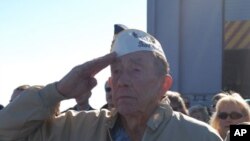On December 7, 1941, Charles Ellis was a 19-year-old seaman on board the battleship USS Pennsylvania in Pearl Harbor, Hawaii. He had joined the Navy the previous year, soon after completing high school. His work entailed cleaning the ship’s deck.
|
Listen to the full interview with Charles Ellis |
“I’d had breakfast, and I was on my way to my cleaning station, and all of a sudden the alarm sounded,” Ellis said. “When that sounded, it was general alarm, and you knew something was up. And that’s when I went to my battle station.”
His station was in one of the turrets holding the ship’s larger guns. As he assumed his position, Ellis saw planes coming in from all directions. He said they were easily identifiable as Japanese.
“They were coming in so low, you couldn’t miss that red insignia," he said.
Hundreds of planes participated in the air assault not only on Pearl Harbor, but also on the U.S. Army, U.S. Army Air Corps and Marine bases on the island of Oahu.
“We were firing the guns,” he said. “That’s all we could do. We were fortunate; we were sitting there and firing our five-inch [13-centimeter] guns, firing at those planes that were coming in from all directions," he said.
The attack on Pearl Harbor lasted about an hour. Ellis’s ship was in dry dock, so it couldn’t be sunk. But two destroyers, sitting in the dry dock in front of the USS Pennsylvania, were badly hit, including the USS Shaw.
Day of infamy
More than 2,400 Americans were killed and eight battleships were damaged, five of which sank. It was the worst foreign attack on American soil until the September 11 attacks in 2001. The remains of the USS Arizona lie in Pearl Harbor as a memorial to all those who died.
In the days before the attack, Ellis said there had been no rumors that an air raid was imminent.
“Being a seaman, they wouldn’t have told us anything anyhow, but there was no indication of any problem," he said.
When it was over, Ellis surveyed the wreckage of the attack that crippled U.S. air and naval power in the Pacific.
“From where I was, you could see the battleships sunk and all the fire and explosions going on, it was quite an exciting time,” he said, adding that he did not have much time to think about the implications. “We didn’t know if they’d gone, if they were coming back, so we were busy getting ammunition and reloading.”
Following the bombing, Ellis, now 89, went to flight training and became a naval aviator. He served in the western Pacific, and finished the war in Tokyo Bay at the signing of the Japanese surrender. After a 20-year career in the U.S. Navy, he flew planes for a grocery company in Florida for another 20 years.
Now retired and living in Jacksonville, Florida, Ellis says the attack on Pearl Harbor will always remain with him and his fellow survivors.
“It’s something that you never forget, believe me,” he said. “We just think about what happened and those days, and we’ll never forget it.”








